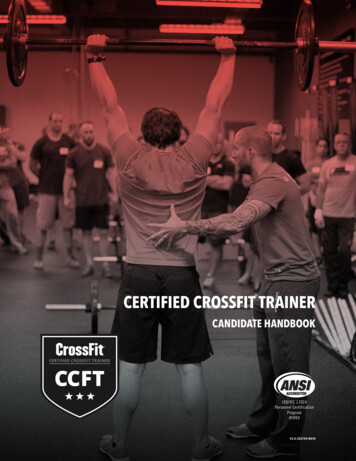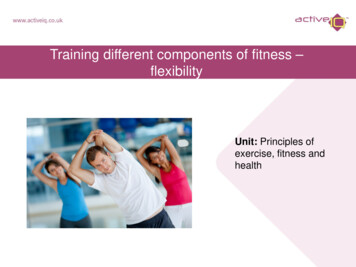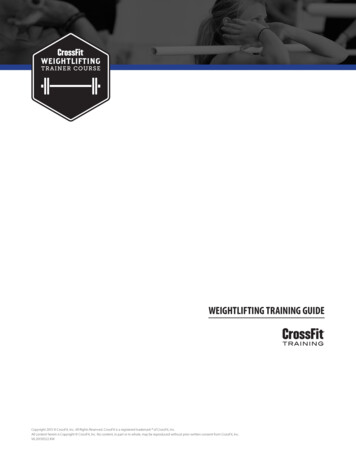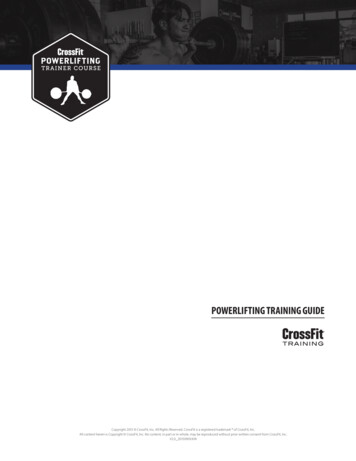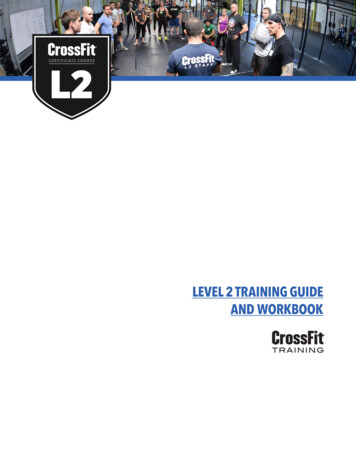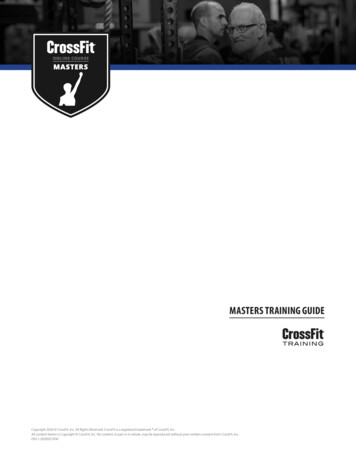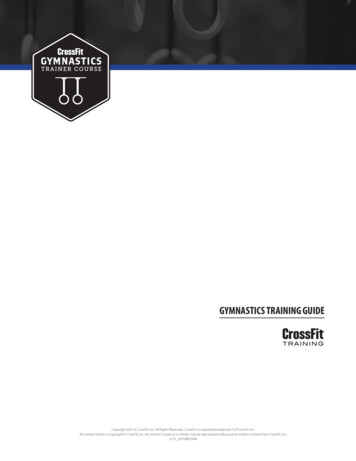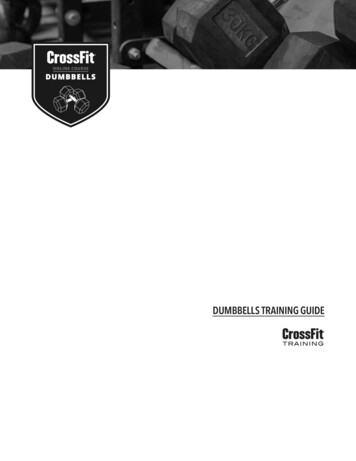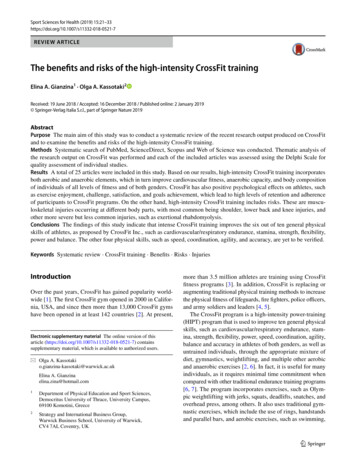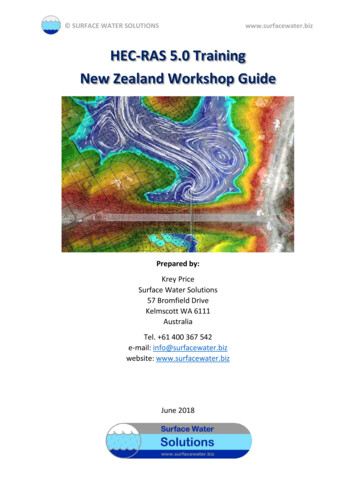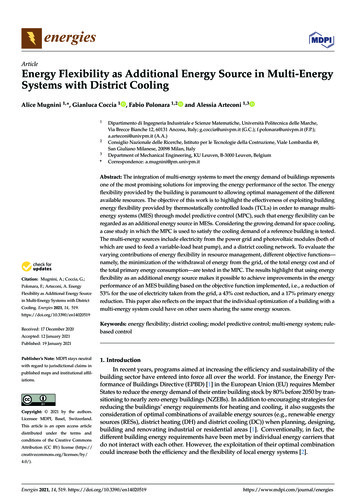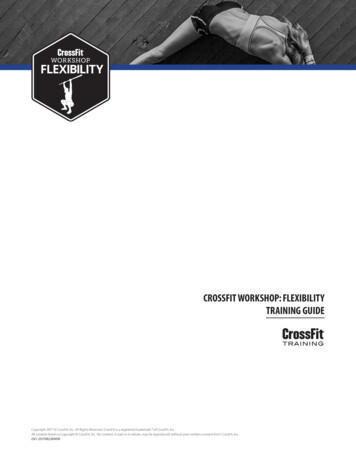
Transcription
CROSSFIT WORKSHOP: FLEXIBILITYTRAINING GUIDECopyright 2017 CrossFit, Inc. All Rights Reserved. CrossFit is a registered trademark of CrossFit, Inc.All content herein is Copyright CrossFit, Inc. No content, in part or in whole, may be reproduced without prior written consent from CrossFit, Inc.DV1-20170822R4KW
CrossFit Workshop: Flexibility :Training GuideTABLE OF CONTENTSINTRODUCTION. . . . . . . . . . . . . . . . . . . . . . . . . . . . . . . . . . . . . . . . . . . . . . . . . . . . . . . . .JOINT ROTATIONSOVERVIEW. . . . . . . . . . . . . . . . . . . . . . . . . . . . . . . . . . . . . . . . . . . . . . . . . . . . . . .5. . . . . . . . . . . . . . . . . . . . . . . . . . . . . . . . . . . . . . . . . . . . . . . . . . . . . . . . . . .5UPPER-BODY JOINT ROTATIONS. . . . . . . . . . . . . . . . . . . . . . . . . . . . . . . . . . . . . . . . . . .LOWER-BODY JOINT ROTATIONS .TORSO TECHNIQUES .DYNAMIC STRETCHING. . . . . . . . . . . . . . . . . . . . . . . . . . . . . . . . . . . . . . . . . . 13. . . . . . . . . . . . . . . . . . . . . . . . . . . . . . . . . . . . . . . . . . . . . 21. . . . . . . . . . . . . . . . . . . . . . . . . . . . . . . . . . . . . . . . . . . . . . . . . .24. . . . . . . . . . . . . . . . . . . . . . . . . . . . . . . . . . . . . . . . . . . . . . . . . . . . . . . . . .24LOWER-BODY DYNAMIC STRETCHES . . . . . . . . . . . . . . . . . . . . . . . . . . . . . . . . . . . . . .27. . . . . . . . . . . . . . . . . . . . . . . . . . . . . . . . . . . . . . .32. . . . . . . . . . . . . . . . . . . . . . . . . . . . . . . . . . . . . . . . . . . . . . . . . . .36. . . . . . . . . . . . . . . . . . . . . . . . . . . . . . . . . . . . . . . . . . . . . . . . . . . . . . . . . .36UPPER-BODY DYNAMIC STRETCHESLOADED STRETCHINGOVERVIEW7. . . . . . . . . . . . . . . . . . . . . . . . . . . . . . . . . . . . . . . . . . . . . . . . . . . 19COMBINATION MOVEMENTS.OVERVIEW3LOWER BODY IN MOTION TECHNIQUES . . . . . . . . . . . . . . . . . . . . . . . . . . . . . . . . . . . .40. . . . . . . . . . . . . . . . . . . . . . . . . . . . . . . . . . . . .46LOWER BODY PNF TECHNIQUES. . . . . . . . . . . . . . . . . . . . . . . . . . . . . . . . . . . . . . . . . .49UPPER BODY PNF TECHNIQUES . . . . . . . . . . . . . . . . . . . . . . . . . . . . . . . . . . . . . . . . . .54. . . . . . . . . . . . . . . . . . . . . . . . . . . . . . . . . . . . . . . . . . . . . . . . . . .58. . . . . . . . . . . . . . . . . . . . . . . . . . . . . . . . . . . . . . . . . . . . . . . . . . . . . . . . . .58UPPER BODY IN MOTION TECHNIQUESPASSIVE STRETCHINGOVERVIEWLOWER BODY .UPPER BODY. . . . . . . . . . . . . . . . . . . . . . . . . . . . . . . . . . . . . . . . . . . . . . . . . . . . . . .60. . . . . . . . . . . . . . . . . . . . . . . . . . . . . . . . . . . . . . . . . . . . . . . . . . . . . . . .65SAMPLE ROUTINES. . . . . . . . . . . . . . . . . . . . . . . . . . . . . . . . . . . . . . . . . . . . . . . . . . . . .BOTTOM OF THE SQUAT . . . . . . . . . . . . . . . . . . . . . . . . . . . . . . . . . . . . . . . . . . . . . . .AT THE BEGINNING OR BOTTOM OF THE SQUATOVERHEAD6970. . . . . . . . . . . . . . . . . . . . . . . . . . . . . .79. . . . . . . . . . . . . . . . . . . . . . . . . . . . . . . . . . . . . . . . . . . . . . . . . . . . . . . . .82FRONT RACK. . . . . . . . . . . . . . . . . . . . . . . . . . . . . . . . . . . . . . . . . . . . . . . . . . . . . . . .LUNGE POSITION. . . . . . . . . . . . . . . . . . . . . . . . . . . . . . . . . . . . . . . . . . . . . . . . . . . . .DEADLIFT/PULLING SET-UPBOTTOM OF A DIP97. . . . . . . . . . . . . . . . . . . . . . . . . . . . . . . . . . . . . . . . . . . . . 103. . . . . . . . . . . . . . . . . . . . . . . . . . . . . . . . . . . . . . . . . . . . . . . . . . . . 1122 of 115Copyright 2017 CrossFit, Inc. All Rights Reserved.V1-20170822R4KW88
CrossFit Workshop: Flexibility :Training GuideINTRODUCTIONINTRODUCTIONThis manual contains information on several styles of flexibility training. By the end of thiscourse, participants should be able to identify and utilize these methods to increase therange of motion needed to perform functional movements well.To begin, we will look at few basic principles of flexibility training and define a fewcommon terms.BASIC CONCEPTSThere are two important terms to define when discussing an individual’s range of motion.1. Flexibility: the range of motion that can be PASSIVELY displayed at a joint (i.e., a seatedforward reach to stretch the hamstrings).2. Mobility: the range of motion that can be ACTIVELY displayed at a joint (i.e., a straightlegged high kick in front of the body).Flexibility will often reveal the maximum range of motion available at a joint becausecompounding factors such as load and speed are not involved. For this reason, one’s flexibility will often dictate how much mobility one can display in a “best-case” scenario. Forease of discussion, flexibility will be used as a catch-all term to describe available range ofmotion (ROM) throughout this manual.Mobility will be contextually defined based on several factors. For example, the speed andmuscular tension required during a movement will dramatically affect one’s ability to display mobility due to the nervous system’s governance of available range of motion. Thisis an important factor to consider when attempting to develop greater range of motion.If you want to develop great flexibility under load while moving quickly, your flexibilitytraining should include quick movements under load.Greatest potential to display ROMLeast potential to display ROMStatic/slow movementsFast movementsExplosive movementsUnloaded/light loadingModerate loadingHeavy loadingFLEXIBILITY AND CROSSFITThis manual outlines several different styles of flexibility training. Before you begin workingdiligently on the techniques below, ask yourself honestly, “How much flexibility do I need?”Increased flexibility for the sake of flexibility alone is not a worthy pursuit if you are interested in fitness. Like any other attribute, too much can be a hindrance rather than a help.For the most part, it is optimal to have only a small reserve of flexibility beyond what isneeded for the performance of functional movements. Too much flexibility can result inpositional laxity, instability of the joints and increased risk of injury. Splits and back bendsare flashy and impressive to the average person but are often not functionally useful foranything other than theatrics.3 of 115Copyright 2017 CrossFit, Inc. All Rights Reserved.V1-20170822R4KW
CrossFit Workshop: Flexibility :Training GuideINTRODUCTIONConsider the following positions. The range of motion of the joints and musculaturerequired to performed them constitute a relatively complete picture of the major musclegroups and joint structures of the body: The bottom of a squat (particularly the overhead squat)o Hips, hamstrings, thoracic and lumbar spine, ankles and calves The bottom of a lungeo Hips, hamstrings, quadriceps, hip flexors The overhead position (particularly with a narrow/shoulder-width grip)o Thoracic spine, lats, pecs, shoulders The front-rack positiono Thoracic spine, lats, pecs, shoulders and triceps, external rotation of the arms The set-up of a deadlift (or other pulling movements like the snatch)o Hamstrings, glutes, thoracic and lumbar spine The bottom of a dip or muscle-upo Pecs, lats, shoulders, thoracic spineIf the positions in the list above can be attained easily with good mechanics, there is littleneed for a dramatic increase in range of motion, and flexibility training should be considered mostly as a maintenance routine.If these positions are not easily attained with good mechanics, increasing ROM can be ahuge benefit to performance and safety. Individuals who struggle with these positionsshould pursue flexibility training as they would address any other weakness in their fitness: head-on with diligent practice.Most people are acutely aware when they have difficulty with a position, but the methodsused for gaining flexibility are often inefficient and tedious. The length of the muscle orsome other mechanical property of the tissue is perceived as the limiting factor. Long,static-stretching grudge matches are often the common prescription for improvement.Static stretching can increase flexibility, but it does a poor job of addressing neurologicalrestriction. For this reason, it is often not the most efficient way to increase ROM requiredfor dynamic, athletic movement.The nervous system plays a large role in governing our movement and will restrict rangesbased on weakness (real or perceived) and unfamiliarity. Re-training the nervous systemby regular exposure and strengthening of these positions can be a more efficient use oftime. Methods that consider this concept often yield a more dramatic improvement thanstatic stretching alone.If you can break out of the mindset that increased flexibility must come from arduous,boring practice, you will find that improvements come relatively quickly with a little bit ofdiligence and hard work.4 of 115Copyright 2017 CrossFit, Inc. All Rights Reserved.V1-20170822R4KW
CrossFit Workshop: Flexibility :Training GuideJOINT ROTATIONSJOINT ROTATIONSOVERVIEWJoint rotations should be done every day to improve overall joint health and movement.Why:Improve synovial-fluid circulation and blood flow. Increase core temperature of the body.Move and expose joints to their natural, full range of motion.What:Movement that places joints through a full, controlled range of motion with minimaleffort or loading. When:First thing in the morning or as the first elements of a workout. How:Starting with small motions, move the joint deliberately through its natural range. Pick at least one drill for each joint.Select a few more drills to emphasize joints that will be more involved in yourworkout or add more repetitions to the original drills you selected.How Much:Minimum of 10 repetitions (each direction) of each movement or until motion issmooth and fluid. When performed as part of a complete workout, no more than approximately 5minutes of total work. When performed as a stand-alone session, the duration is up to you, but stop beforethe point of muscular fatigue.How Often:Can be performed every day (recommended). The term “joint rotations” can be a bit misleading, because not all movements will includerotation. Joint rotation simply refers to unloaded movement that moves joints throughtheir full ranges of motion with minimal effort. We are not looking for an acute stretch ofthe musculature, although athletes might experience some light stretching sensations.Joint rotations serve as excellent daily practice as part of a warm-up or as the first movements after waking. Joint rotations encourage circulation of synovial fluid (fluid whichlubricates joints), blood flow and controlled range of motion. They are also very useful forincreasing the body’s core temperature while preparing the body and nervous system formore intense activities.The minimum recommendation is typically 10 reps in each direction; however, many morecan be done if desired. A common practice is to do as many repetitions as needed to feelthat the joint is rotating smoothly and easily. It is recommended to start with a small,controlled rotation and gradually increase range of motion and speed. Working from the5 of 115Copyright 2017 CrossFit, Inc. All Rights Reserved.V1-20170822R4KW
CrossFit Workshop: Flexibility :Training GuideJOINT ROTATIONSextremities toward the center of the body is an easy way to stay organized (i.e., wrists àelbows à shoulders ankles à knees à hips).If a joint is recovering from injury, use pain-free range of motion as a guide. You mighthave to limit yourself initially. Gentle, frequent rotations can be used to slowly improveand encourage a return to full range of motion. The increased blood flow can alsohelp heal an injury by way of delivering necessary nutrients and clearing inflammatorycompounds.There are endless variations on these drills. The basics will serve you well, but if you findsome alternatives you like, feel free to use them. However, do not feel the need to be creative at the expense of efficacy. If a drill seems convoluted or overcomplicated, it probablyis. When in doubt, fall back on the basics.Due to the infinite variations, it is possible to spend an inordinate amount of time working these movements, but most warm-up applications require only five to 10 minutes. Beconsistent (i.e., daily practice), but don’t major in the minors! Spending all of your trainingtime here at the expense of your primary workout is not the way forward!You can also use some drills that involve a small amount of resistance or traction toencourage the use of the muscles responsible for active movement of the joint. Use thisapproach sparingly and remember the goal is circulation, encouragement of full rangeof motion, and increased core temperature and nervous system activity, NOT muscularfatigue/failure or a pronounced stretch.There is a natural blurring between many joint rotation and dynamic stretching techniques. The primary difference: Joint rotations are often performed with control throughthe whole range of motion and are therefore less dynamic. Try to execute the movementssmoothly instead of explosively. By contrast, dynamic stretching techniques often rely onchange of direction just before the moment of stretch to be most effective.Joint rotations do not create significant fatigue and encourage the natural movement ofthe joints. Including them as part of a daily routine is a very simple, effective and time-efficient practice to promote and maintain joint health. These movements are not oftenthought to improve flexibility, but their regular practice can have a great impact on overallmovement quality.6 of 115Copyright 2017 CrossFit, Inc. All Rights Reserved.V1-20170822R4KW
CrossFit Workshop: Flexibility :Trai
Begin as above. Once over the stick, send the leading leg under the stick, using a wider placement than before. As you are passing under the stick, rotate the torso to face away from the rack and raise the hands overhead in one smooth motion. Make sure both feet rotate or
